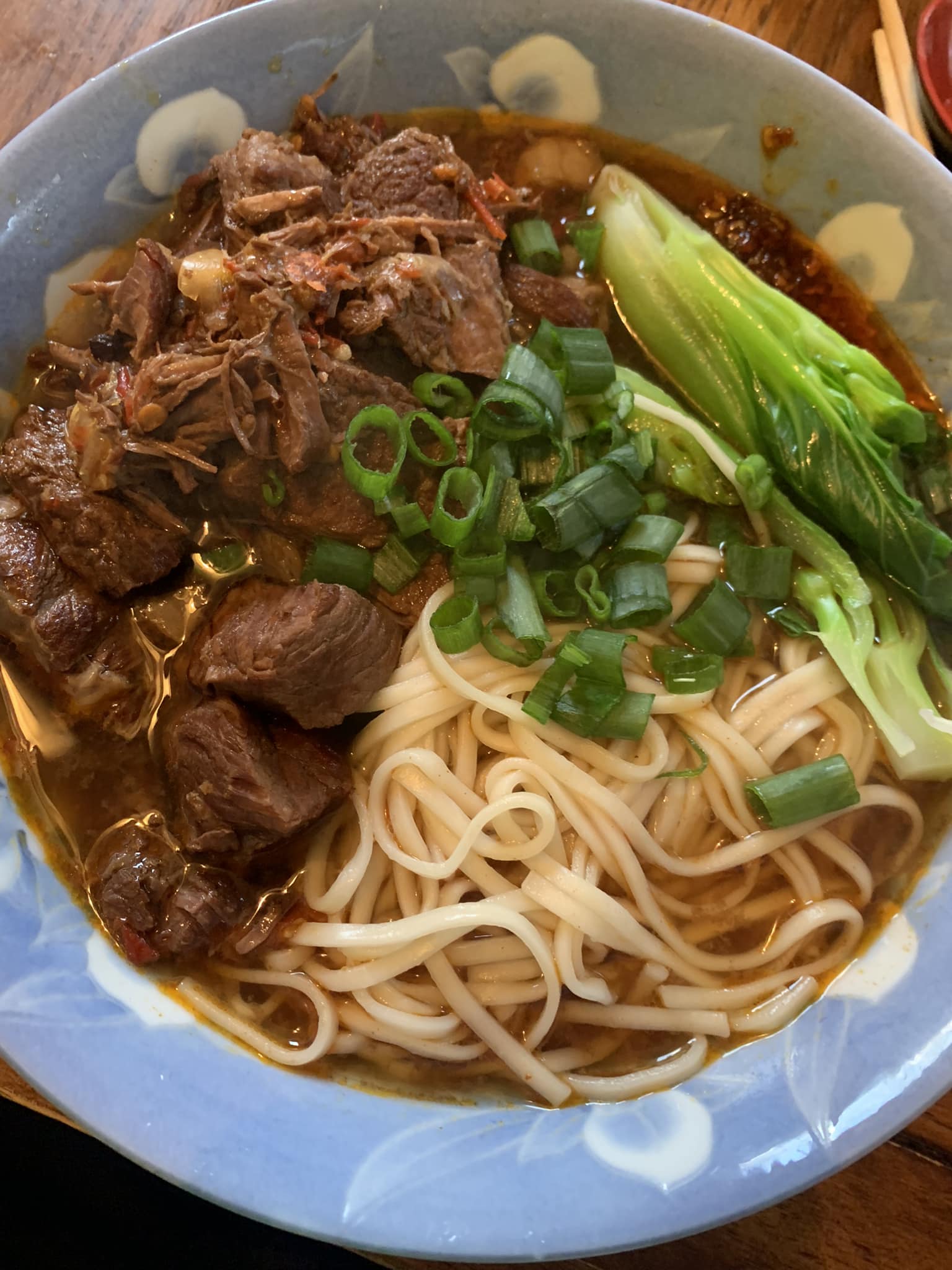
Spicy Beef Noodle Soup
Spicy Beef Noodle Soup

Ingredients:
For stewing the beef
600 g beef, cut in cubes – 21oz
2 tablespoon cooking oil
4 cloves garlic, minced
3 tablespoon Sichuan chilli bean paste – see note 1
½ teaspoon chilli powder
1500 ml hot water – 6½ cups
1 thumb-sized ginger
2 stalks scallions, cut in sections
1 bay leaf
1 star-anise
1 small piece Chinese cinnamon/cassia cinnamon
10 Sichuan pepper
1 pinch fennel seeds
½ teaspoon sugar
You also need:
4 portions noodles – see note 2
Spinach – or pak choi / bok choy
Fresh coriander, chopped
Instructions:
Blanch the beef
Add beef cubes to a pot filled with water.
Bring it to a full boil.
Remove any impurities that appears on the surface.
Drain then put the beef back into the pot.
Prepare the soup
Heat up oil in a wok (or a deep frying pan) over medium heat.
Stir in garlic, Sichuan chilli bean paste and chilli powder.
Cook until fragrant (do not burn).
Pour in 1500ml (6½ cups) hot water.
Cover and leave to simmer for 5 minutes.
Simmer the beef
Through a sieve, pour the spiced soup into the beef pot.
Add ginger, scallions and all the other spices (see note 3).
Bring the soup to a boil then simmer for 1 to 1.5 hours.
Once the beef becomes tender cooked, discard the ginger, scallions and spices.
Cook the noodles
Cook the noodles in another pot with plenty of water.
At the end of the process, quickly blanch spinach (or pak choi) in the same pot.
Drain and rinse the noodles and vegetable under cold water for a few seconds.
Assemble the dish
Place the noodles and vegetable in serving bowls.
Pour in the broth then place the beef on top.
Sprinkle coriander to garnish. Serve immediately (see note 4).
Notes:
1. Different brands of Sichuan chilli bean paste (aka spicy Doubanjiang) may vary in saltiness, hotness and texture. Adjust the volume accordingly. Best to use Pixian Douban, a well-known variety, which needs to be coarsely chopped prior to cooking.
2. You may use fresh noodles or dried noodles. In terms of volume, I usually cook about 80-100g / 2.8-3.5 oz dried noodles for each person. Follow the instructions on the package. Please note that you are not supposed to boil the noodles in the beef broth since the starch coming off the noodles will change the flavour and the consistency of the broth.
3. If available, use a closed tea strainer to keep spices in while simmering. Later you will be able to discard them easily.
4. You may freeze the meat and soup in the freezer for up to 1 month. Defrost in the fridge then heat up again prior to serving.
Frequently Asked Questions:
What is Sichuan chilli bean paste, and can I substitute it?
Sichuan chilli bean paste is a spicy and flavorful condiment.
You can substitute it with other spicy bean pastes or even Korean gochujang for a different twist.
What type of noodles work best for this soup?
You can use various noodles like wheat noodles, rice noodles, or even egg noodles.
Choose your favorite type or experiment for different textures.
Can I use pre-packaged beef broth instead of making it from scratch?
While making the broth from scratch enhances flavor, you can use pre-packaged beef broth as a time-saving alternative.
Adjust seasoning accordingly.
What other vegetables can be added to the soup?
Feel free to add vegetables like mushrooms, bean sprouts, or thinly sliced bell peppers for added texture and flavor.
Can I make this soup less spicy?
Absolutely. Adjust the amount of Sichuan chilli bean paste and chilli powder to control the spice level according to your preference.
Is there a substitute for Chinese cinnamon/cassia cinnamon?
You can use regular cinnamon as a substitute. However, Chinese cinnamon has a slightly different flavor profile, so adjust the quantity to your taste.
Can I make this soup ahead of time?
Yes, you can prepare the broth and stew the beef in advance.
Assemble the soup with noodles and vegetables just before serving to maintain freshness.
Is there a vegetarian version of this soup?
You can make a vegetarian version by using vegetable broth and substituting tofu or plant-based protein for the beef.
How can I store leftover soup?
Store leftover soup in an airtight container in the refrigerator.
Reheat on the stove or in the microwave before serving.
What are some optional toppings for this soup?
Consider adding sliced green onions, a squeeze of lime, or a drizzle of sesame oil as optional toppings for additional flavor.
Leave a Reply